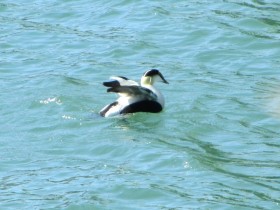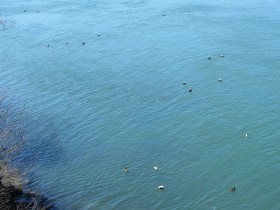 “Best known for its soft, warm down”, the large diving sea-duck common eider, according to Audubon*, is “most easily observed because of its tendency to remain close to shore and its relative abundance, especially in northeastern North America. This cold ocean inhabitant is the largest duck in the Northern Hemisphere.”
“Best known for its soft, warm down”, the large diving sea-duck common eider, according to Audubon*, is “most easily observed because of its tendency to remain close to shore and its relative abundance, especially in northeastern North America. This cold ocean inhabitant is the largest duck in the Northern Hemisphere.”
While this bird’s range is from Alaska to Greenland, the common eider visits Maine in summer and Long Island, New York in winter. It is not generally found in any other states.
Native Americans harvested their eggs for consumption, but did not return to harvested nesting sites for several years to allow for recovery.
Common eiders were almost completely eliminated as a species in the 19th century, from over hunting and egg destruction. An effort to protect their nesting sites has been successful in the ducks’ return to a healthy species. A regulated hunting season is allowed in Maine.
Eiders nest in colonies of 200 or more pairs per acre. They tend to return to their nesting places each year. In Maine that is usually April on coastal islands.
The human-like moaning sound in the video is uttered by the male during courtship. The female quacks.
Their food is primarily mussels and other shellfish, which they swallow whole. Their stomachs crush the shells.
More Videos!
* “Common Eider.” at http://birds.audubon.org/species/comeid (accessed September 17, 2011)
Additional resources
Allen, R. Bradford. “Common Eider Assessment.” Maine. Department of Inland Fisheries and Wildlife. Augusta, Me. October, 2000. http://www.maine.gov/ifw/wildlife/species/plans/birds/commoneider/speciesassessment.pdf (accessed April 21, 2013)


